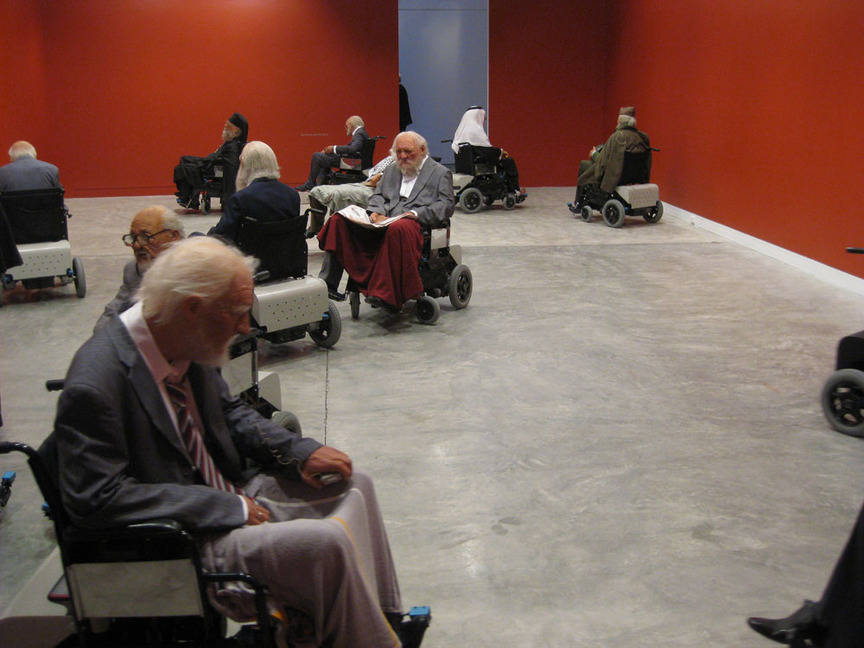
R
E
V N
E
X
T
From left to right, Johnnie Walker, Uli Sigg and Fang Lijun, standing in front of Lijun’s Untitled,1995, at the National Portrait Gallery, Canberra, 2012. Courtesy Johnnie Walker.
Fang Lijun enjoys almost rock star status in the contemporary Chinese art world. He is as much at home in the company of western politicians as he is in one of his several studios (or for that matter in any one of his eight restaurants). Last week he was holding court at a group show which opened at Canberra’s National Portrait Gallery (NPG). “Go Figure: Contemporary Chinese Portraiture” is an exhibition of 55 works drawn from the collection of Swiss businessman and former diplomat, Uli Sigg, and is currently being shown simultaneously at two venues, the second being Sydney’s Sherman Contemporary Art Foundation (SCAF).
Lijun had two works in the show and what stunners they were: Untitled (1995) and 1998.8.25 (1998), as fresh and luminous, I imagine, as the day they were painted. Color from the canvases flooded the dull gallery space. In front of Untitled, an anatomical study of the back of the artist’s own bald head, Lijun engaged comfortably with the media even hamming it up with Uli Sigg and Japanese art entrepreneur, Johnnie Walker. I can confidently say that, after having studied up close the bald heads of the three art tsars over the days preceding the opening (September 13), no two phrenological expanses are the same. Like fingerprints, or snowflakes, each person’s cranial valleys and mounds are unique.
The show was all great fun even while the Great Helmsman’s voice screamed with the vigor of a despot from speakers hidden behind a vintage microphone, a work by He Xiangyu titled Dedicated to Her: Loudspeaker (2011). The standing microphone was set near Yue Minjun’s oil painting Founding Ceremony (1997). Based on Dong Xiwen’s The Founding Ceremony of the Nation (1953), Yue’s painting presents the same diminutive view over Tiananmen Square from the platform at Tiananmen Gate where Mao and his cronies—absent here—would have surveyed the grey-suited masses.
SHEN SHAOMIN, Standard Portrait, 2009, oil on silicone, at Sherman Contemporary Art Foundation, Sydney, 2012. Photo by Michael Young for ArtAsiaPacific.
Mao’s image plays a fairly major role in this exhibition with the inclusion of several iconic works, including Wang Guangyi’s Mao Zedong: Red Grid No.2 (1988) and Yu Youhan’s Untitled (Mao Marilyn) (2005). In the Sydney component of “Go Figure,” Shen Shaomin’s Standard Portrait (2009) features a portrait of Mao painted on a soft-framed, un-stretched, silicone canvas that slips down off the wall to become a deconstructed heap on the floor. The work is effective at demythologizing the image of the Great Leader, although that’s probably not quite what the CCP had in mind when they implemented their policy of soft cultural diplomacy.
Not on display was another of Shen’s Mao pieces, the hyper-real Great Corpse (2006), and Shen expressed disappointment, when ArtAsiaPacific met with him earlier this year, that Sigg did not release this work for exhibition in Sydney. Great Corpse is based on the naked and dead body of the Chairman much as it would appear when removed from its Tiananmen Square mausoleum for annual cleaning. Sigg told AAP that during the planning stages of “Go Figure,” Sigg was in an advanced stage of negotiating the donation of the majority of his museum-class collection of contemporary Chinese art to China and talks were at a far too delicate stage to risk being derailed by what would surely prove to be a controversial piece.
The central work displayed at SCAF was Sun Yuan and Peng Yu’s Old People’s Home (2007), consisting of 13 hyper-real decrepit septuagenarians in 13 motorized and computer controlled wheelchairs that perambulate the gallery space. Although not based on actual world leaders—the models were actually derelicts and homeless people the artists encountered on the streets of Europe—they do, through very contrived clothing, take on the persona of such leaders. As a consequence the inevitable guessing game occurs among visitors: Yasser Arafat, Archbishop Makarios, Ho Chi Minh?
Yasser Arafat was very badly behaved. The front wheels of his wheelchair crept up one of the gallery’s burgundy walls and the wheelchair toppled backwards with a resounding crack onto the concrete floor. Fortunately no damage, to either floor or head, was perceptible. Fidel Castro crept up on Sigg from behind and nudged him ever so gently. Sigg’s doppleganger, a hyper-real sculpted portrait by Ai Weiwei (Newspaper Reader, 2004), which sits resolutely by the door, remained unmoved and unmoving as King Faisal of Saudi Arabia made a break for freedom, negotiating the door to the street with consummate skill.
One of the artists responsible for this mayhem, Sun Yuan was as much a part of the work as the 13 old men. Smiling benignly, Sun steered Faisal into reverse and back in among the others. When Karl Marx needed to have his hair fixed, Sun, with a blob of hair gel settling glutinously in the palm of his hand and a comb and hair dryer in the other, set delicately about the wiry coiffeur with an unexpected degree of professionalism. Only later when he talked to AAP did it emerge that he had taught hairdressing and the dubious art of make-up at a college in Beijing many, many years ago.
Such is the world of Old People’s Home. While humorous, it is also a chilling, reflective memento mori on death and aging. “Humor,” Sun told AAP, forms one of the key elements of his work along with aesthetics and the ability to be critical.
“Go Figure: Contemporary Chinese Portraiture” is on show at the NPG in Canberra until February 15, 2013 and at Sydney’s SCAF until December 1.





